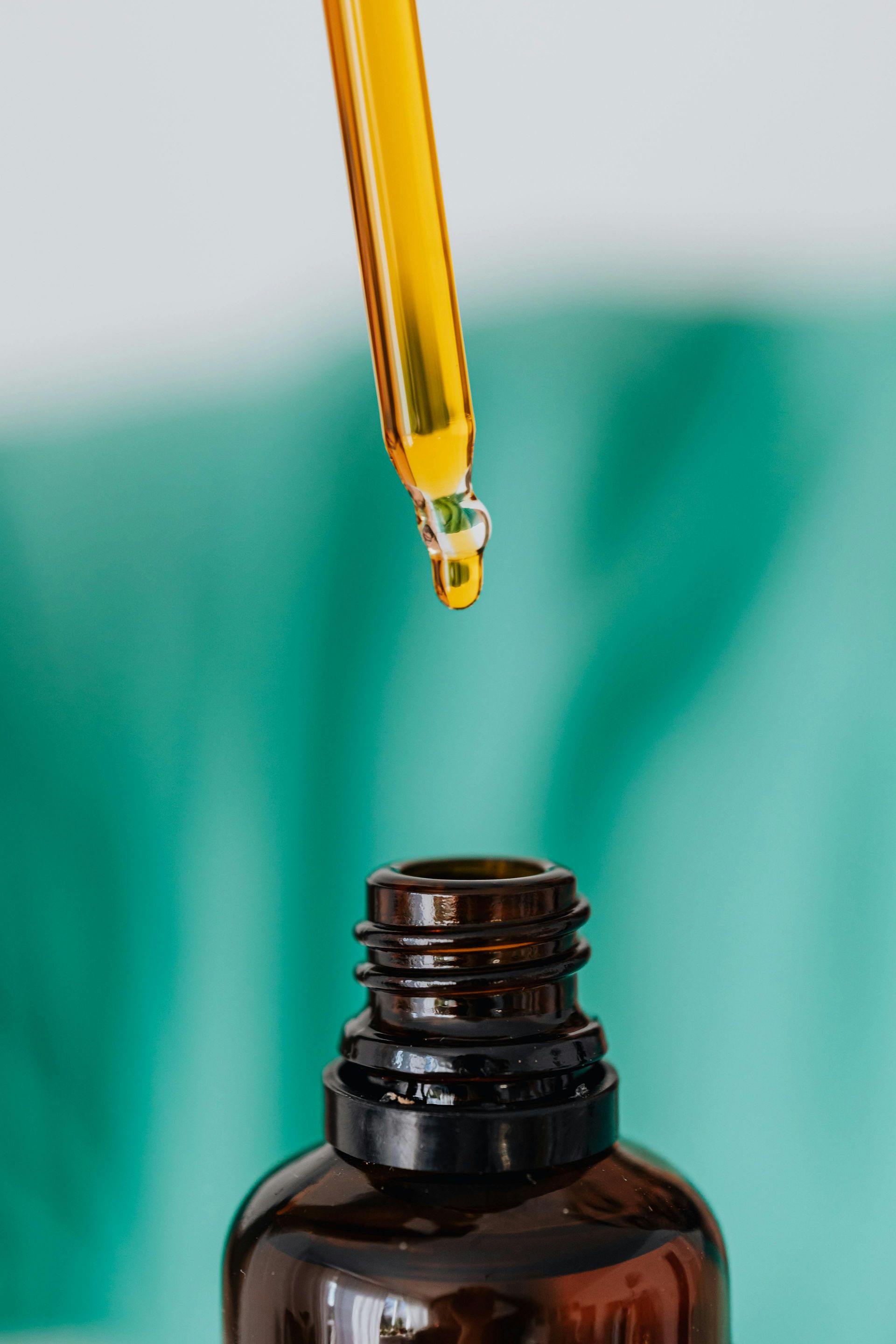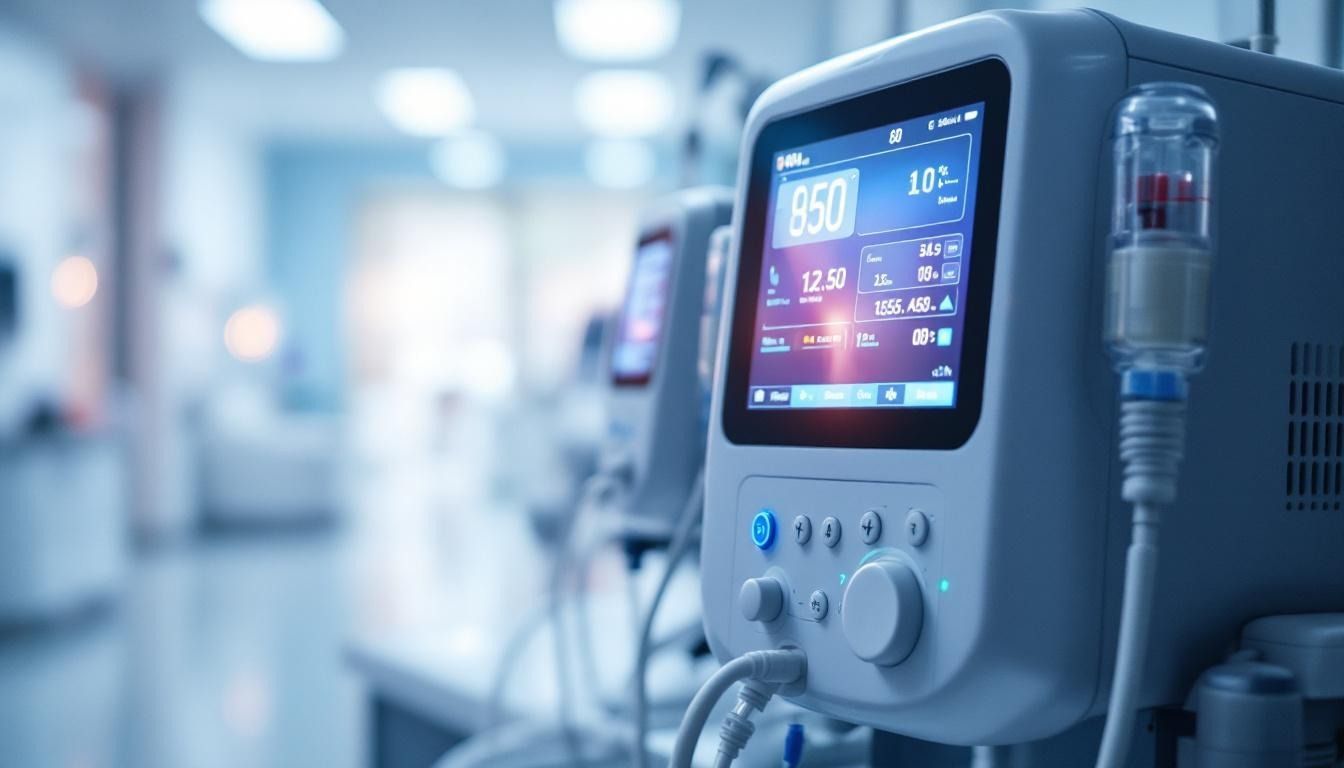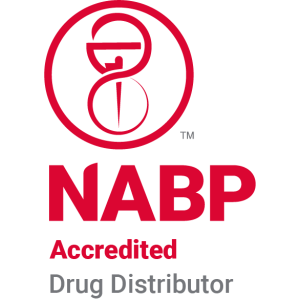How to Improve Nutrient Absorption in Patients Receiving IDPN
Understanding the Foundations of Nutrient Absorption in IDPN Therapy
Proper nutritional support in dialysis patients is critical for improving outcomes, especially given the challenges posed by malabsorption and metabolic disturbances. Intradialytic Parenteral Nutrition (IDPN) offers a targeted approach to deliver essential nutrients directly into the bloodstream during dialysis sessions, bypassing the compromised gastrointestinal tract. This article explores strategies, evidence-based guidelines, and clinical considerations to optimize nutrient absorption and efficacy in patients receiving IDPN, aiming to support their metabolic needs, prevent complications such as refeeding syndrome, and ultimately improve their quality of life.
Differences Between IDPN and TPN and Their Roles in Nutritional Support
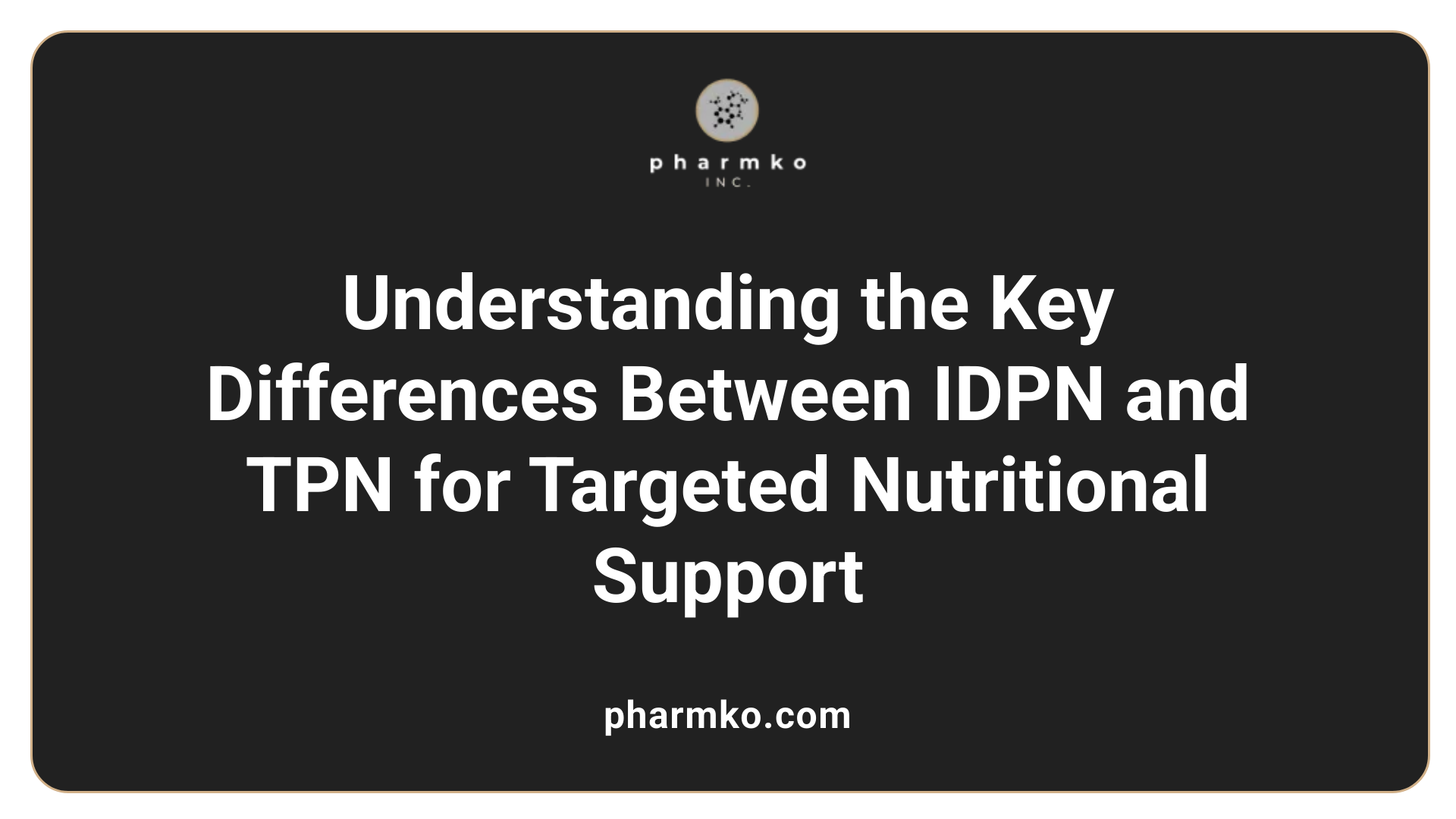
How do IDPN and TPN differ, and what are their respective roles in nutritional support?
IDPN (Intradialytic Parenteral Nutrition) and TPN (Total Parenteral Nutrition) are both methods of delivering nutrients directly into the bloodstream via intravenous infusion. However, they serve different purposes tailored to specific patient populations.
IDPN is administered during dialysis sessions to support patients with end-stage renal disease (ESRD) who are experiencing malnutrition or protein-energy wasting (PEW). It provides essential nutrients such as amino acids, dextrose, and lipids directly during hemodialysis, aiming to improve nutritional markers like serum prealbumin and albumin. IDPN is usually a short-term intervention, typically lasting at least 3 to 6 months, and is intended for patients who cannot meet their nutritional needs through oral supplements or enteral feeding.
On the other hand, TPN offers comprehensive nutritional support for patients who cannot utilize their gastrointestinal (GI) tract effectively. It is used in cases of bowel failure, severe malabsorption, or conditions requiring long-term nutritional management. TPN provides all necessary nutrients—amino acids, glucose, lipids, electrolytes, vitamins, and trace elements—and can be administered continuously over longer periods.
Application scenarios
- IDPN is used during dialysis sessions for malnourished dialysis patients, especially when oral intake is inadequate.
- TPN is employed for patients with non-functioning GI tracts, such as Post-surgical bowel obstruction or severe inflammatory bowel disease.
Patient populations suited for each therapy
| Patient Population | Therapy Type | Details |
|---|---|---|
| Dialysis patients with PEW | IDPN | Short-term support during dialysis, improves serum albumin and prealbumin, helps maintain or improve nutritional status |
| Patients unable to use gut | TPN | Long-term use in cases of bowel failure or severe malabsorption, provides complete nutritional replacement |
| Patients with bowel disease or post-surgical bowel obstruction | TPN | Supports nutritional needs when enteral feeding is impossible |
Both IDPN and TPN are vital tools in clinical nutrition, chosen based on the patient’s specific medical condition, nutritional deficits, and overall treatment goals.
Nutritional Options for Patients on TPN and Considerations for Oral Intake

What are the options for patients on TPN to consume food orally, and what are the considerations?
Patients undergoing total parenteral nutrition (TPN) can sometimes consume food orally if their gastrointestinal (GI) tract is functioning adequately. This approach, known as oral intake during TPN, allows patients to benefit from natural digestion and absorption, which can support gut health and improve overall well-being.
However, the ability to eat orally depends on several factors. For instance, patients with bowel obstructions, severe malabsorption, or compromised GI function may not tolerate oral intake and could be at risk of complications like diarrhea, cramps, or aspiration pneumonia. In such cases, oral feeding might be contraindicated or limited.
When oral intake is permitted, it should be initiated gradually and carefully. This cautious approach helps prevent GI disturbances and ensures the patient can tolerate the new intake without adverse effects. Close coordination among healthcare providers—including physicians, dietitians, and nurses—is key to designing an appropriate plan.
Monitoring is vital throughout this process. Regular assessments help tailor dietary choices and detect early signs of issues such as intolerance, aspiration, or nutritional deficiencies. The transition from exclusive TPN to combined oral and parenteral nutrition requires careful planning to synchronize intake levels with metabolic needs.
The decision to allow or restrict oral feeding alongside TPN hinges on individual health status, the type of TPN used, and the specific medical reasons for parenteral nutrition. Overall, personalized nutritional strategies and ongoing evaluation are essential to optimize patient safety and nutritional outcomes during this complex process.
Monitoring and safety considerations during combined nutritional support
When patients receive both TPN and oral intake, vigilant monitoring helps ensure safety and effectiveness. This includes checking electrolyte levels, blood glucose, and signs of GI intolerance. Adjustments to the TPN composition or oral intake volume are made based on laboratory results and clinical observations.
Additionally, monitoring for complications such as refeeding syndrome—a dangerous shift in electrolytes seen when reintroducing nutrition—befits from a careful, slow approach, especially in malnourished patients.
When should oral feeding be introduced or increased?
Oral feeding should be considered when the patient's medical condition improves and they show signs of GI tolerance. This process often begins with small, easy-to-digest foods and slowly escalates as tolerated.
In conclusion, appropriately managed oral intake during TPN can enhance nutritional status, support gut integrity, and improve quality of life. However, it necessitates cautious initiation, individualized planning, and constant supervision to avoid complications and meet the patient’s nutritional goals.
Nutritional Needs and Management in Dialysis Patients
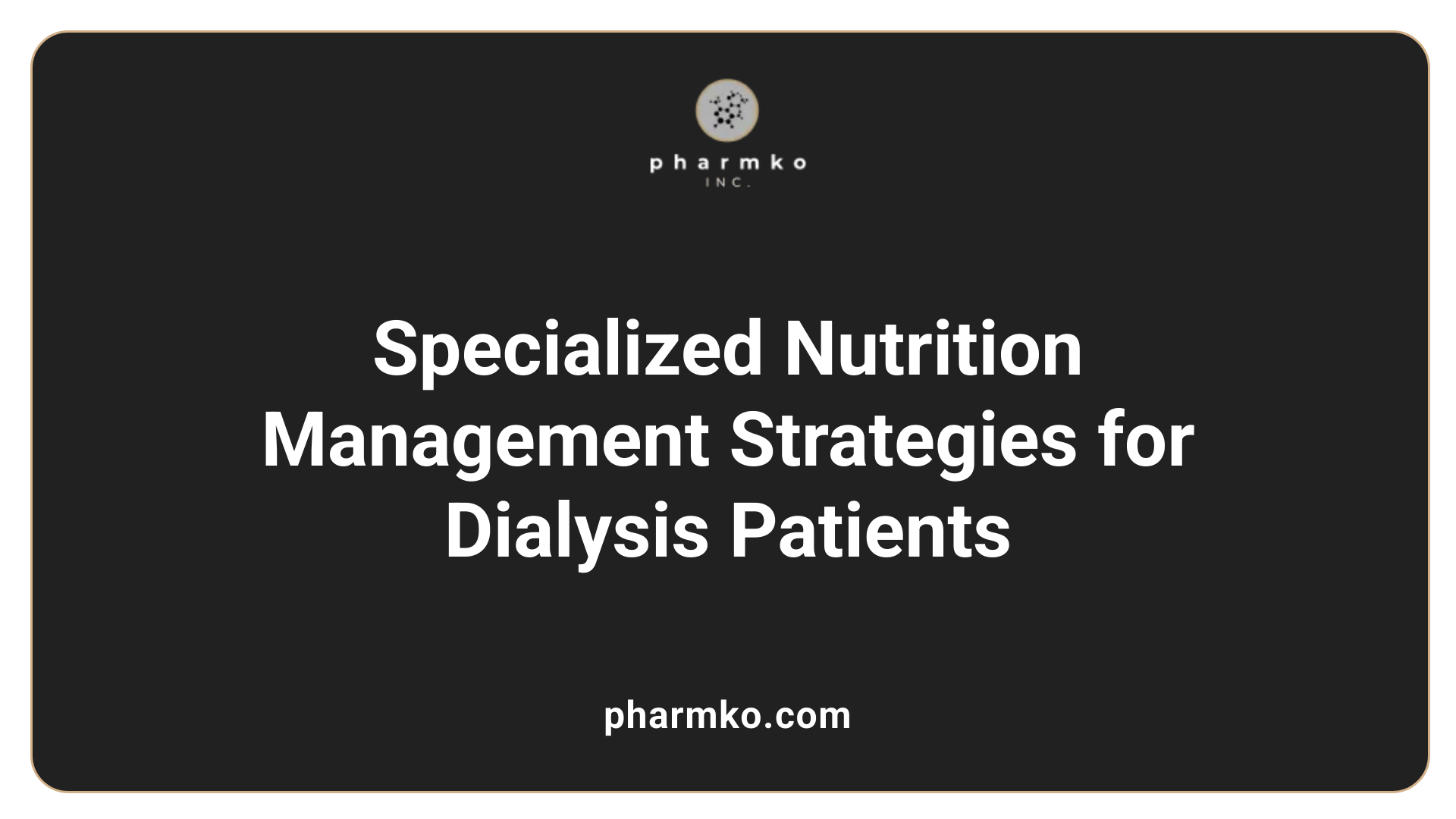
What are the nutritional considerations specific to patients requiring dialysis?
Patients on hemodialysis face unique nutritional challenges that require careful management to support their health and treatment success. They generally need higher intakes of high-quality protein, approximately 1.2 to 1.3 grams per kilogram of body weight daily, to compensate for protein losses during dialysis sessions.
Managing mineral intake is equally critical. Phosphorus, commonly found in processed foods and phosphate additives, must be limited to prevent bone disease and skin problems. Phosphate binders may be prescribed to help control serum phosphate levels.
Fluid management is tailored to individual needs, often involving restrictions based on urine output and residual kidney function. Excess fluid intake can lead to swelling, hypertension, and heart strain, so patients need to monitor their liquid intake carefully, including water-rich foods like soups, fruits, and vegetables.
Electrolyte regulation, especially for potassium and sodium, is vital. Blood potassium levels influence dietary potassium intake, which may need to be adjusted to prevent dangerous swings like hyperkalemia. Sodium intake is typically limited to reduce thirst, fluid retention, and fluctuations in blood pressure.
To ensure a balanced diet, patients usually work with a renal dietitian who can design personalized meal plans. These plans focus on delivering sufficient calories, controlling mineral intake, and avoiding excess fluids, all while incorporating essential vitamins and micronutrients.
In summary, effective nutritional management in dialysis patients requires a comprehensive approach that considers the individual's biochemical status, dietary preferences, and treatment regimen. Proper nutrition can help improve quality of life, reduce complications, and support treatment goals.
Strategies for Improving Nutrient Absorption in IDPN Patients
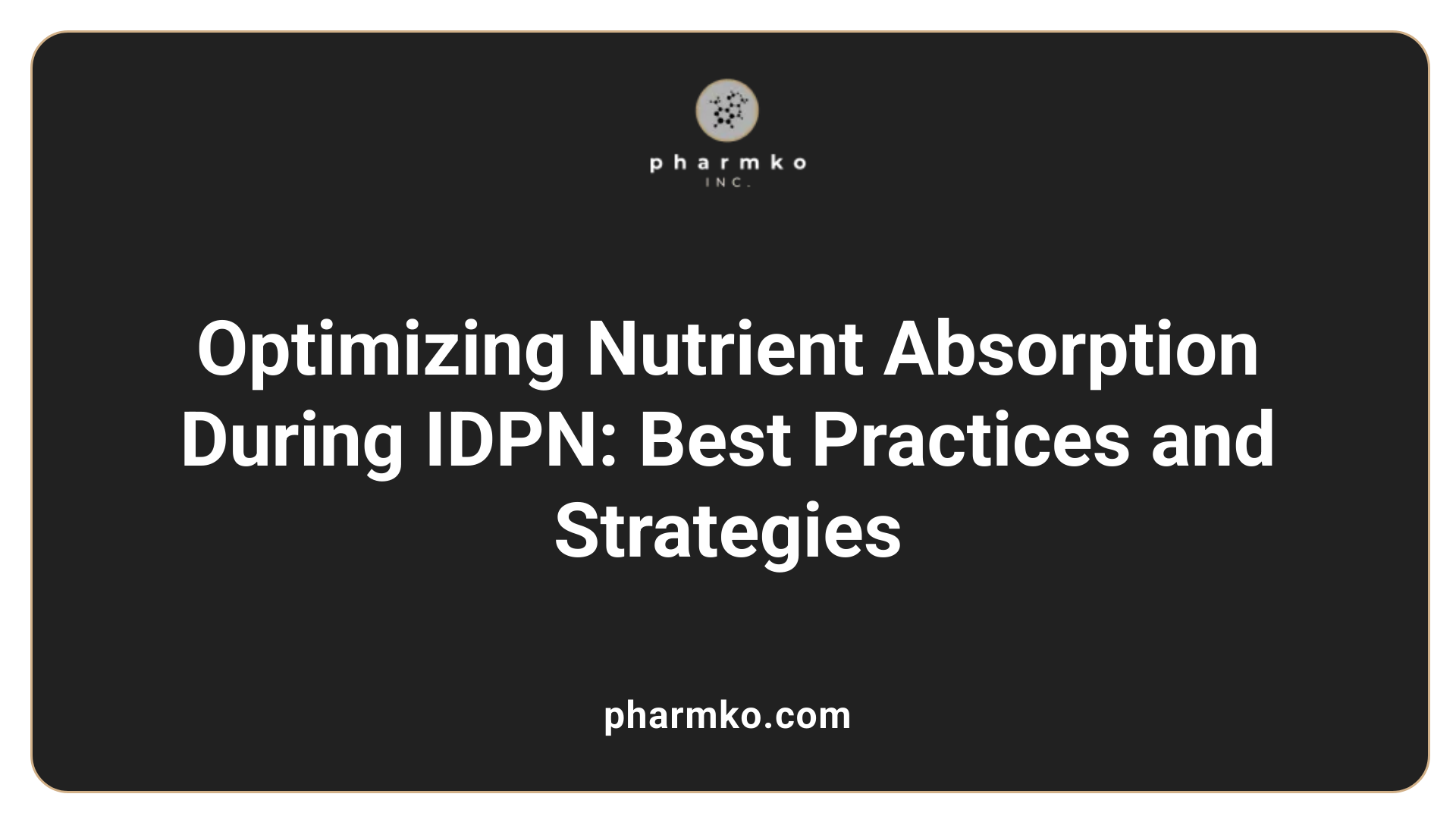
What are the strategies and best practices for improving nutrient absorption in patients receiving Intradialytic Parenteral Nutrition (IDPN)?
Optimizing nutrient absorption during IDPN involves a multifaceted approach centered on ensuring that patients receive the right nutrients and that their metabolic conditions support efficient utilization.
First, providing high-quality amino acids is crucial. The composition of IDPN solutions should target amino acid provision over 0.5 g/kg body weight per session to overcome anabolic resistance and compensate for intradialytic amino acid loss.
Addressing metabolic disturbances is equally important. Systemic inflammation and metabolic acidosis are common in dialysis patients and can impair protein synthesis. Correcting metabolic acidosis with oral bicarbonate supplementation can reduce muscle protein breakdown, thereby improving nutritional status.
Managing systemic inflammation involves eliminating potential sources like infections and adjusting dialysis prescriptions to reduce inflammation triggers. Controlling inflammation helps prevent catabolism and enhances the body’s ability to absorb and utilize nutrients.
Incorporating targeted nutritional interventions also boosts absorption. This includes adjusting the composition of IDPN solutions—such as tailoring glucose, amino acids, and lipid content—to meet individual patient needs, and considering adjunctive oral nutritional supplements.
Ensuring continuous monitoring of biochemical markers, such as serum prealbumin, albumin, blood glucose, and triglycerides, helps assess the effectiveness of nutritional strategies and allows for timely adjustments.
Lastly, an integrated treatment plan combining nutritional support, pharmacological management, and dialysis optimization creates the best environment for nutrient absorption. Addressing all these areas collectively maximizes nutrient uptake and enhances overall outcomes for patients on IDPN.
Guidelines and Evidence-Based Interventions for Nutritional Optimization During IDPN Therapy
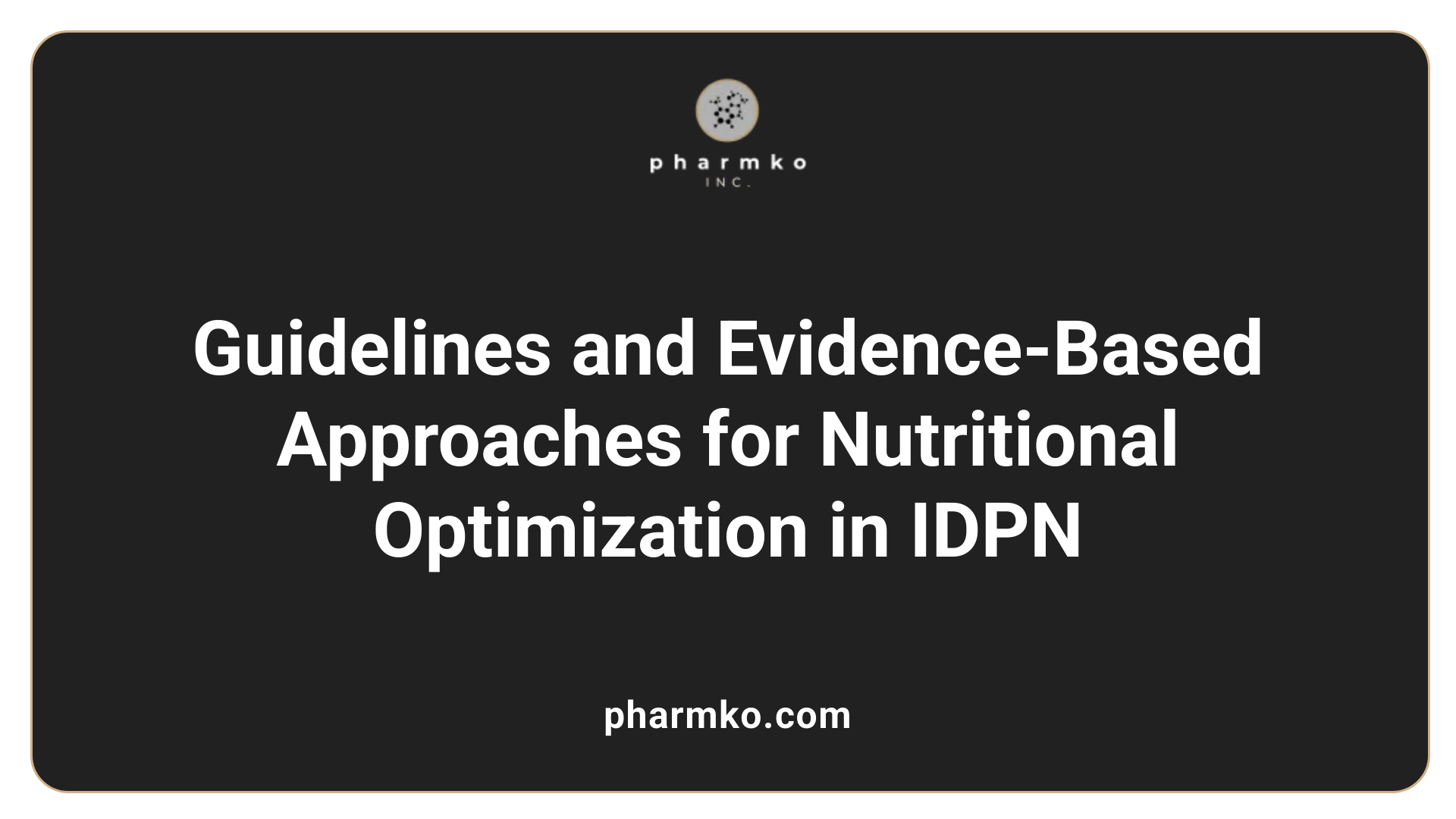
What clinical guidelines and evidence-based interventions exist for optimizing nutrition during IDPN therapy?
Effective nutritional management during Intradialytic Parenteral Nutrition (IDPN) relies on well-established clinical guidelines and evidence-based practices. These guidelines emphasize careful selection of patients who are most likely to benefit, such as those with moderate to severe malnutrition, unintentional weight loss, low serum albumin or prealbumin levels, or inadequate oral intake.
To determine necessity, healthcare providers evaluate nutritional status with tools like Subjective Global Assessment (SGA), Body Mass Index (BMI), and serum markers. Patients typically considered for IDPN are those on maintenance hemodialysis who have not responded to dietary counseling or oral nutritional supplements (ONS), especially after 4 to 6 months of supportive care.
Formulation adjustments are central to successful therapy. The composition should deliver at least 50 grams of amino acids per session, targeting a provision of >0.5 g/kg body weight. Carbohydrates in the form of dextrose are controlled, usually ranging from 50 to 80 grams per session, to prevent hyperglycemia. Lipid emulsions such as SMOFlipid® or Intralipid® are incorporated judiciously, with doses generally between 30–50 grams, tailored to maintain triglycerides within safe limits.
Monitoring is critical for safety and efficacy. Blood glucose levels, serum lipids, liver function tests, and electrolytes such as phosphate, potassium, and magnesium are checked regularly. Nutritional markers like serum prealbumin and albumin are tracked to gauge response. Physical assessments, including muscle mass and strength, contribute to comprehensive evaluation.
Multidisciplinary oversight involves nephrologists, renal dietitians, pharmacists, and nursing staff. They coordinate initiation, infusion management, and ongoing re-evaluation. The infusion rate is typically set to deliver nutrients steadily over at least 3.5 hours during dialysis, starting at approximately 125 mL/hour and increasing as tolerated.
These practices are supported by guidelines from organizations such as the National Kidney Foundation’s Kidney Disease Outcomes Quality Initiative (KDOQI), the American Society for Parenteral and Enteral Nutrition (ASPEN), and the Centers for Medicare & Medicaid Services (CMS). The overarching goal is to tailor therapy to individual needs, avoid complications like hyperglycemia and hyperlipidemia, and continually reassess nutritional targets to optimize patient outcomes.
Methods to Enhance Nutrient Uptake and Balancing Infusion Components
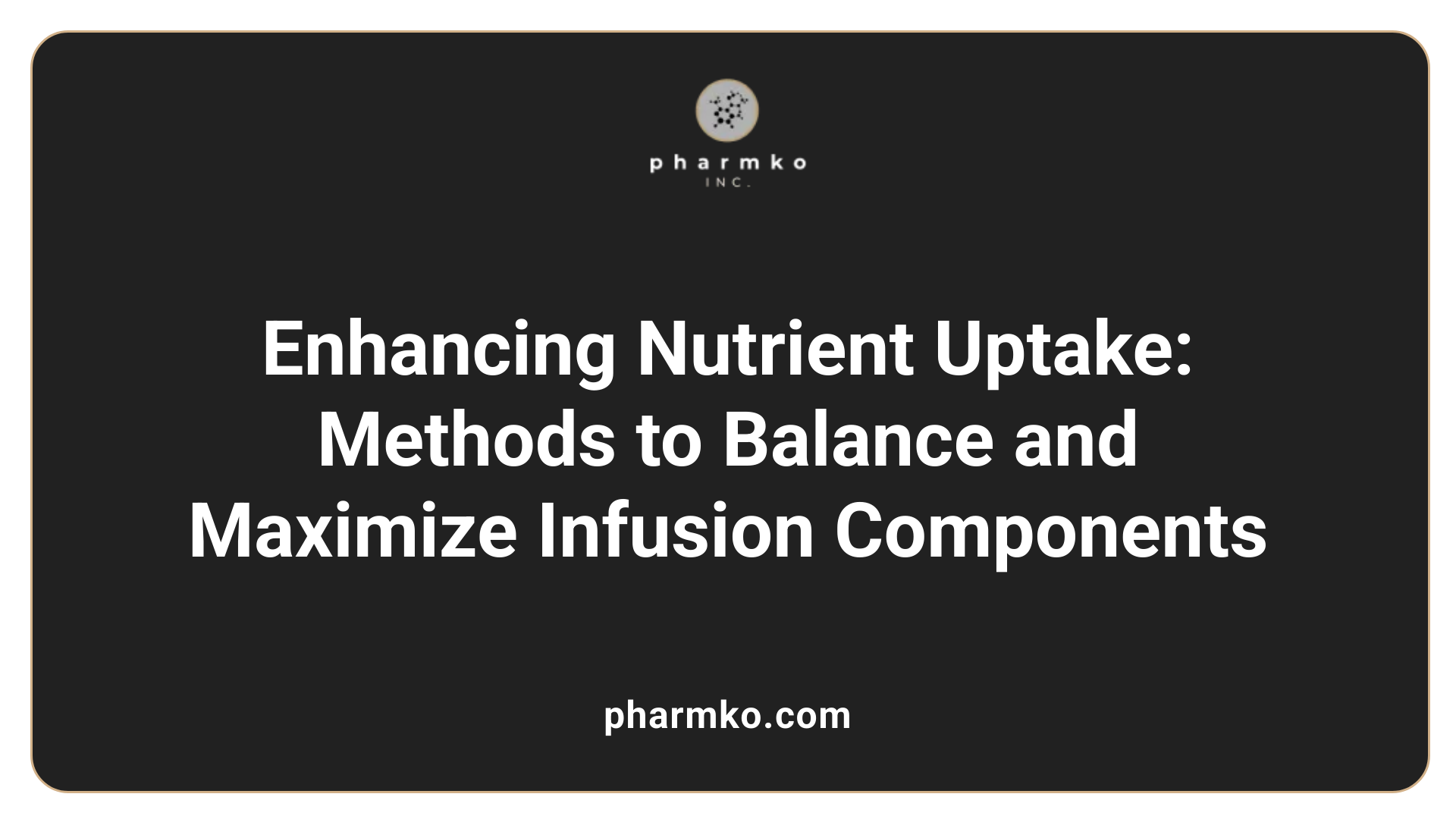
What methods can be used to enhance nutrient uptake and efficiency in patients receiving IDPN?
Optimizing the composition of intradialytic parenteral nutrition (IDPN) is essential for maximizing the benefits of therapy in malnourished hemodialysis patients. One of the primary strategies involves providing adequate amino acids, with dosing typically around 0.5 to 0.6 grams per kilogram of body weight per session. This supports protein synthesis and helps overcome anabolic resistance caused by the dialysis process.
Careful control of glucose levels in the infusion is equally important. Glucose is usually administered in amounts ranging from 50 to 80 grams per session to prevent hyperglycemia while supplying sufficient energy. Adjustments may be necessary based on the patient's blood sugar response and overall metabolic profile.
Lipid management is another key aspect. By tailoring the lipid component—using emulsions such as SMOFlipid® that are less pro-inflammatory—clinicians can optimize essential fatty acid delivery and reduce triglyceride levels. Lipid-free formulations might be considered in patients with hyperlipidemia or fatty liver disease.
Timing and infusion rates during hemodialysis sessions significantly influence nutrient delivery efficiency. Gradually increasing the infusion rate and setting it according to formulation and session duration (typically over 3.5 hours) can improve tolerability and nutrient uptake. Starting at a lower rate, such as 125 mL/hour, and increasing to around 250 mL/hour allows for better adjustment based on patient response.
Monitoring is vital for ensuring efficacy and safety. Regular assessments of blood glucose, triglycerides, liver function tests, and nutritional markers like serum prealbumin and albumin enable clinicians to detect and correct issues promptly. This also includes observing for symptoms of hyperglycemia, hyperlipidemia, or liver dysfunction.
Combining IDPN with physical activity and personalized nutritional counseling may further enhance nutrient utilization. Such integrative approaches can promote an anabolic environment, improve muscle mass, and support overall recovery.
In summary, customizing the infusion's nutrient composition and infusion parameters based on continuous monitoring, along with adjunct interventions, helps optimize nutrient uptake. This holistic approach can significantly improve the nutritional status and clinical outcomes in patients receiving IDPN during hemodialysis.
Nutritional Support Strategies to Address Malabsorption

What nutritional strategies can address malabsorption and improve outcomes in patients receiving IDPN?
In managing malnourished hemodialysis patients, addressing malabsorption is essential for effective nutritional support. Initially, efforts focus on optimizing oral intake, including dietary counseling and oral nutritional supplements (ONS). However, when these measures are insufficient or poorly tolerated, Intradialytic Parenteral Nutrition (IDPN) is considered as an alternative or adjunct.
Guidelines from prominent organizations such as ESPEN and KDOQI emphasize the importance of monitoring specific nutritional markers. Serum albumin and prealbumin levels, along with anthropometric measures like BMI and muscle mass, provide insight into the patient’s nutritional status and response to therapy.
Customizing IDPN formulations to meet individual needs is crucial. These solutions typically deliver amino acids, dextrose, and lipids in proportions tailored to overcome absorption limitations and meet caloric and protein requirements. For example, providing approximately >0.5 g/kg of amino acids per session aims to support protein synthesis, while glucose and lipid content are calibrated to avoid metabolic complications.
Regular assessment of the patient's response, tolerance, and safety is fundamental. Monitoring blood glucose, triglycerides, and signs of fluid overload or intolerance ensures prompt adjustments to therapy. Addressing adverse effects, such as hyperglycemia or lipid abnormalities, helps maintain therapy safety.
Implementing a multidisciplinary approach involving nephrologists, dietitians, and clinical nutritionists is vital. These professionals guide individualized treatment plans, interpret laboratory data, and modify formulations as needed. This collaborative effort maximizes the potential of IDPN to improve nutritional status, muscle mass, and overall health outcomes, especially in those with significant malabsorption issues.
In summary, comprehensive strategies—including initial optimization, individualized nutrient solutions, consistent monitoring, and collaborative care—are essential to effectively manage malabsorption and enhance the benefits of nutritional support in hemodialysis patients receiving IDPN.
Monitoring and Considerations for Maximizing Nutrient Absorption
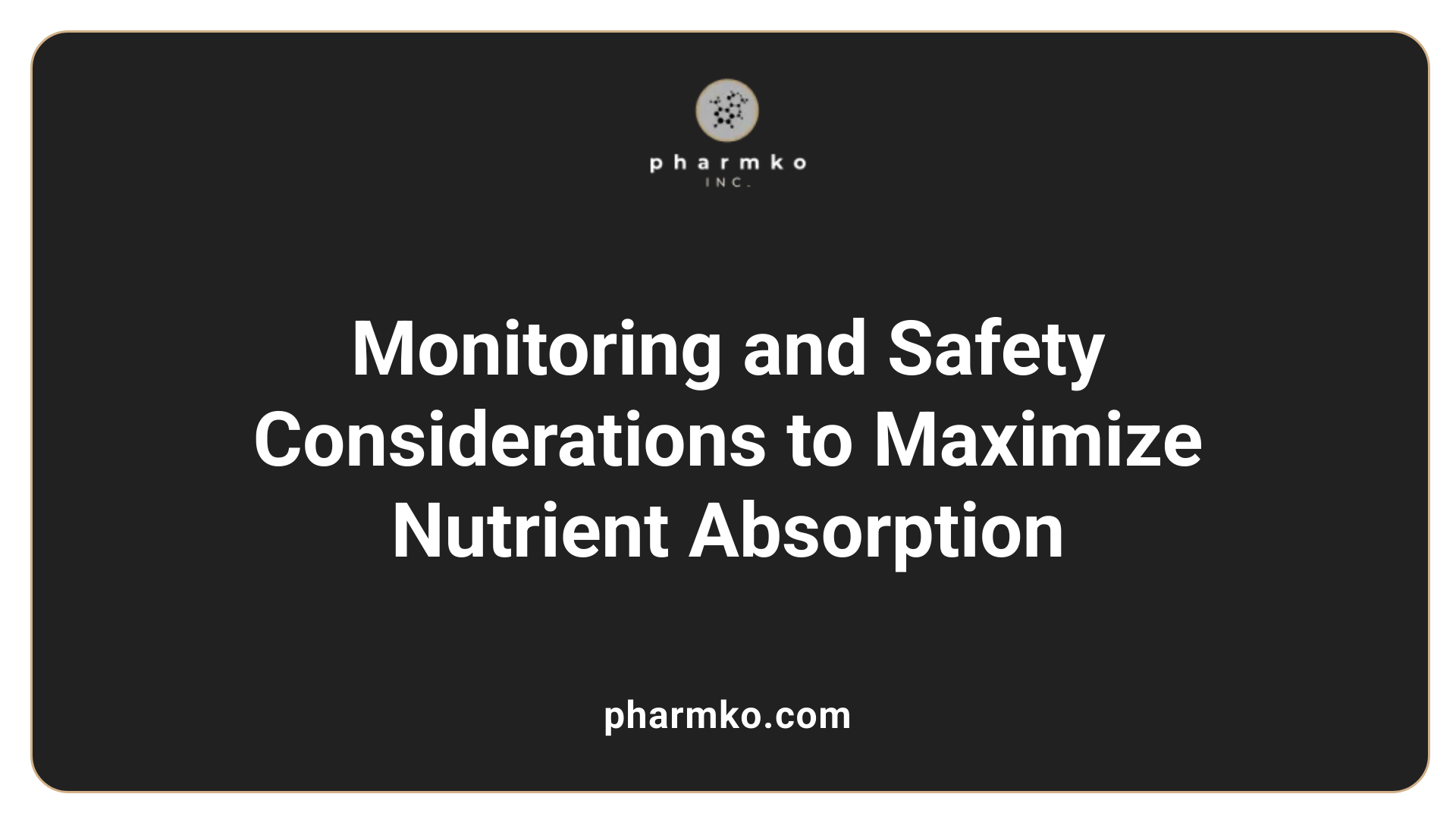
How can clinical monitoring and considerations maximize nutrient absorption in dialysis patients receiving IDPN?
To optimize nutrient uptake during Intradialytic Parenteral Nutrition (IDPN), vigilant clinical monitoring is essential. Regular assessment of blood markers such as prealbumin and albumin provides insight into the patient's protein status and helps gauge the effectiveness of nutritional support. Tracking changes in body weight, muscle mass, and strength offers additional information about overall nutritional health.
Blood glucose levels require close supervision, particularly in diabetic patients, to prevent hyperglycemia. Adjusting insulin doses or choosing formulations with appropriate carbohydrate content can help maintain optimal glycemic control. Monitoring serum lipids, including triglycerides, is also critical to identify lipid intolerance or risk of hyperlipidemia, enabling timely adjustments to lipid infusion rates.
Tailoring the composition of IDPN solutions based on ongoing assessments ensures nutrient delivery aligns with individual needs. This involves adjusting amino acid, carbohydrate, and lipid concentrations to overcome anabolic resistance and compensate for dialysis-related losses.
Fluid status should be carefully evaluated through clinical symptoms and laboratory data to prevent volume overload or dehydration. Adjusting infusion rates or timing, such as initiating infusions after dialysis begins and continuing during the session, helps maximize nutrient absorption while preventing complications.
Continual evaluation of the patient's overall nutritional status—including dietary intake, clinical symptoms, and laboratory markers—guides therapy modifications. This dynamic approach ensures that IDPN effectively supports metabolic demands, promotes gains in protein stores, and contributes to improved clinical outcomes.
Scientific Evidence Supporting Nutritional Support and Absorption in IDPN
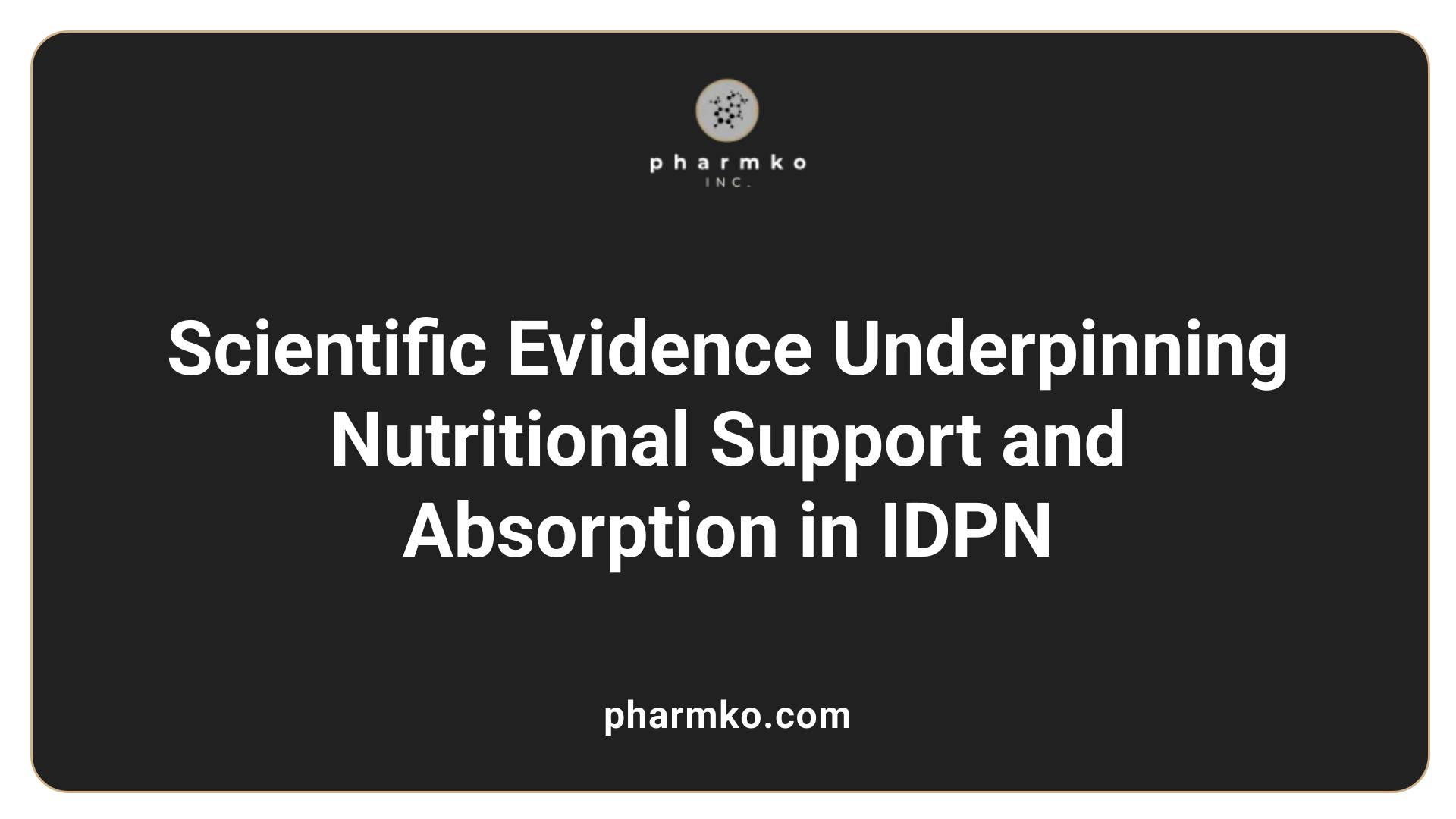
What scientific evidence supports improving nutritional support and absorption in patients on IDPN?
Despite the theoretical benefits of intradialytic parenteral nutrition (IDPN) in enhancing nutritional support, the current scientific evidence does not conclusively demonstrate that it leads to meaningful improvements in clinical outcomes such as survival, hospitalization rates, or quality of life for hemodialysis patients.
Several studies have shown that IDPN can effectively increase serum markers like albumin and prealbumin, as well as body weight and muscle circumference, which are indicators of nutritional status. For example, research conducted by Ikizler (2002) and Cano (2007) indicated that nutritional interventions including IDPN promote increased protein synthesis and better visceral protein status.
However, these biochemical and nutritional improvements do not consistently translate into tangible health benefits such as reduced mortality or fewer hospital admissions. Large, randomized controlled trials (RCTs) have found that while IDPN enhances nutritional markers, it does not significantly influence long-term survival in the general hemodialysis population.
Furthermore, safety profiles suggest that adverse effects of IDPN, including hyperglycemia, hyperlipidemia, or fatty liver, are limited and comparable to control groups. This indicates that the intervention is relatively safe, but the evidence does not support its use solely for absorption enhancement without clear clinical benefits.
A recent systematic review highlights the need for more well-designed, high-quality RCTs that focus on patient-centered outcomes — such as quality of life, functional status, and survival — rather than biochemical markers alone. Without robust evidence, the role of IDPN remains primarily supportive and targeted at improving nutrition markers rather than directly improving health outcomes.
In summary, current research suggests that while IDPN can improve certain nutritional indicators, solid evidence demonstrating its effectiveness in improving overall health, survival, or reducing hospitalizations is lacking. More comprehensive studies are necessary to establish whether improving absorption through IDPN translates into tangible long-term benefits for patients undergoing dialysis.
Preventing Nutrient Absorption-Related Complications, Including Refeeding Syndrome
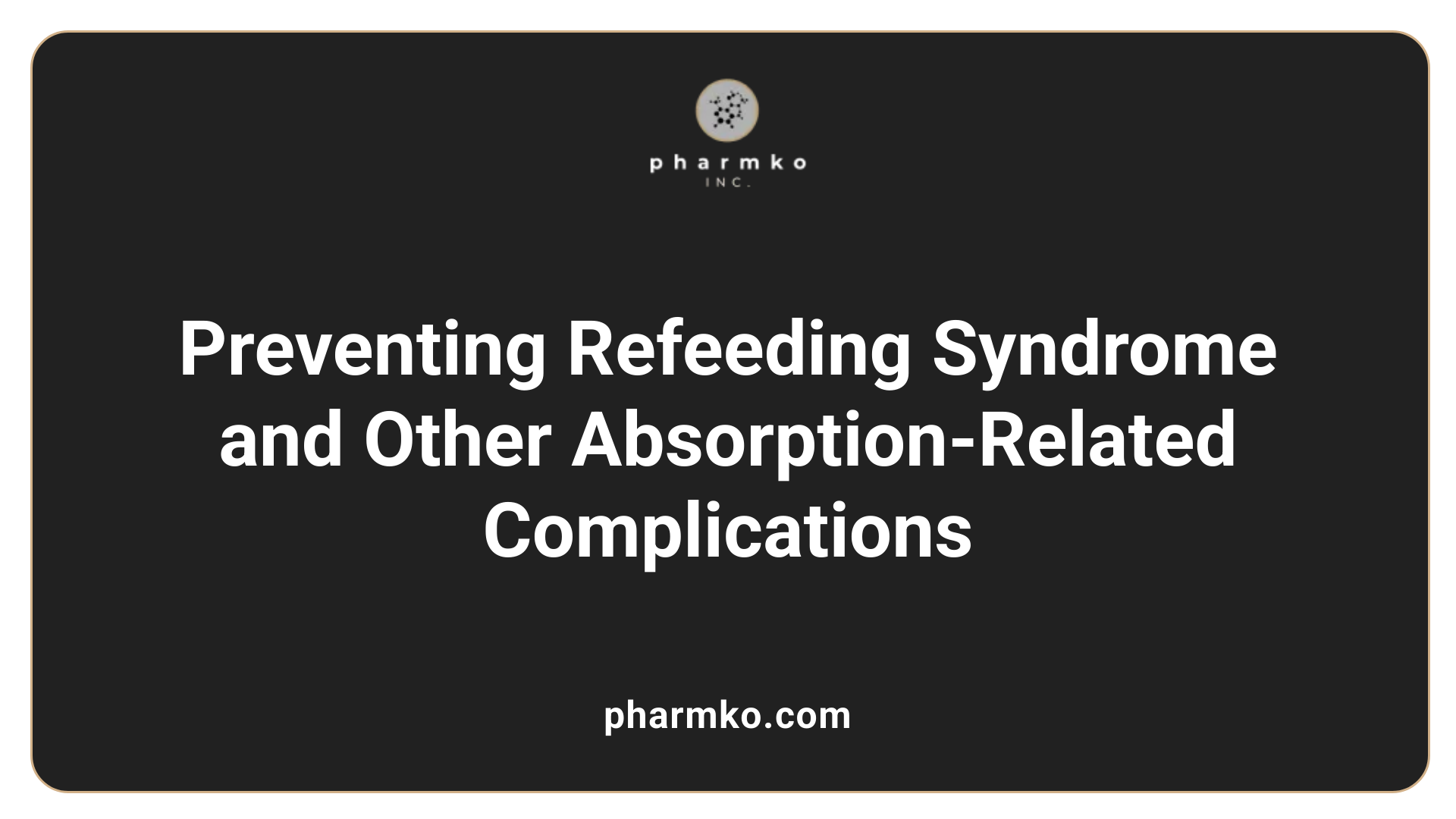
How can complications related to nutrient absorption, such as refeeding syndrome, be prevented in IDPN patients?
Refeeding syndrome is a potentially life-threatening complication that can occur when malnourished patients are reintroduced to nutrition too rapidly or without proper precautions. In patients receiving intradialytic parenteral nutrition (IDPN), especially those with severe malnutrition or significant weight loss, careful planning is crucial to prevent such complications.
The first step involves identifying patients at high risk. Factors such as unintentional weight loss greater than 10%, very low serum albumin levels, or severe malnutrition assessed by clinical tools like the Subjective Global Assessment (SGA) can signal increased vulnerability.
Prior to initiating IDPN, rigorous assessment of electrolyte levels—including phosphate, potassium, and magnesium—is essential. Detecting deficiencies early allows for correction through targeted supplementation, reducing the chance of drastic electrolyte shifts during refeeding.
Once the patient is deemed suitable for nutritional support, refeeding should commence at a very low caloric rate, typically starting with less than 50% of the estimated needs. The infusion rate should be gradually increased over 24 to 48 hours, allowing the body to adapt and reducing the risk of rapid metabolic and electrolyte disturbances.
In addition to slow reintroduction of calories, continuous monitoring of key electrolytes throughout the therapy period is vital. Frequent blood tests enable timely detection of hypophosphatemia, hypokalemia, and hypomagnesemia, facilitating prompt correction with oral or intravenous supplements.
Vitamins such as thiamine play a preventive role against neurological and cardiac complications associated with refeeding syndrome. Supplementing these vitamins before and during refeeding supports cellular energy processes and metabolic stability.
Collaboration between the nephrologist, dietitian, and nursing staff is necessary to tailor nutritional therapy appropriately. Adjustments in dialysis parameters or nutritional doses may be required based on ongoing clinical and laboratory data.
Educating staff and patients about the signs of electrolyte imbalances, arrhythmias, or fluid overload enhances early detection and management of adverse events.
In summary, preventing refeeding syndrome in IDPN involves patient risk assessment, cautious and gradual nutritional repletion, diligent electrolyte monitoring and correction, and supportive vitamin therapy. These measures collectively help ensure a safer refeeding process, minimizing severe metabolic disturbances and associated complications.
Integrating Strategies to Maximize Nutritional Outcomes
Optimizing nutrient absorption in patients undergoing IDPN therapy requires a comprehensive approach that combines targeted nutritional formulations, vigilant monitoring, individualized adjustments, and multidisciplinary collaboration. Adherence to clinical guidelines ensures safe and effective therapy, while proactive management of metabolic disturbances and potential complications like refeeding syndrome minimizes risks. Continuous reassessment based on biochemical, clinical, and functional parameters helps in tailoring intervention strategies, ultimately leading to improved nutritional status, better treatment tolerance, and enhanced quality of life for dialysis patients. As research advances, further clarifying the long-term benefits of IDPN will refine these strategies, ensuring that patients receive optimal nutritional care to support their complex needs.
References
- Intradialytic parenteral nutrition for patients on hemodialysis
- Intradialytic parenteral nutrition in maintenance hemodialysis ...
- [PDF] Intradialytic Parenteral Nutrition (IDPN) - BC Renal
- Artificial Nutritional Support in Chronic Hemodialysis Patients
- Intradialytic Parenteral Nutrition - an overview | ScienceDirect Topics
- Intradialytic Parenteral Nutrition | Providers - Blue Cross NC
- [PDF] Intradialytic parenteral nutrition for patients on hemodialysis
- Nutrition for Malnourished Hemodialysis Patients
- [PDF] Chapter 4 NUTRIENT PRESCRIPTION - National Kidney Foundation



